英语词汇学怎么考 英语词汇学必背知识点
- 格式:docx
- 大小:37.19 KB
- 文档页数:2
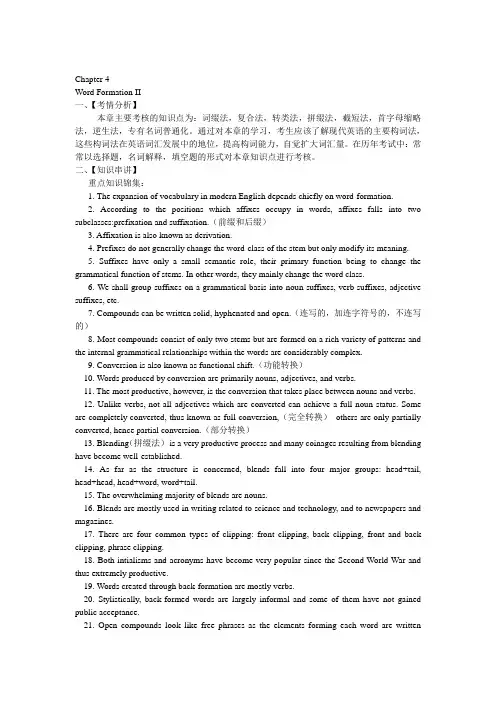
Chapter 4Word Formation II一、【考情分析】本章主要考核的知识点为:词缀法,复合法,转类法,拼缀法,截短法,首字母缩略法,逆生法,专有名词普通化。
通过对本章的学习,考生应该了解现代英语的主要构词法,这些构词法在英语词汇发展中的地位,提高构词能力,自觉扩大词汇量。
在历年考试中:常常以选择题,名词解释,填空题的形式对本章知识点进行考核。
二、【知识串讲】重点知识锦集:1. The expansion of vocabulary in modern English depends chiefly on word-formation.2. According to the positions which affixes occupy in words, affixes falls into two subclasses:prefixation and suffixation.(前缀和后缀)3. Affixation is also known as derivation.4. Prefixes do not generally change the word-class of the stem but only modify its meaning.5. Suffixes have only a small semantic role, their primary function being to change the grammatical function of stems. In other words, they mainly change the word class.6. We shall group suffixes on a grammatical basis into noun suffixes, verb suffixes, adjective suffixes, etc.7. Compounds can be written solid, hyphenated and open.(连写的,加连字符号的,不连写的)8. Most compounds consist of only two stems but are formed on a rich variety of patterns and the internal grammatical relationships within the words are considerably complex.9. Conversion is also known as functional shift.(功能转换)10. Words produced by conversion are primarily nouns, adjectives, and verbs.11. The most productive, however, is the conversion that takes place between nouns and verbs.12. Unlike verbs, not all adjectives which are converted can achieve a full noun status. Some are completely converted, thus known as full conversion,(完全转换)others are only partially converted, hence partial conversion.(部分转换)13. Blending(拼缀法)is a very productive process and many coinages resulting from blending have become well-established.14. As far as the structure is concerned, blends fall into four major groups: head+tail, head+head, head+word, word+tail.15. The overwhelming majority of blends are nouns.16. Blends are mostly used in writing related to science and technology, and to newspapers and magazines.17. There are four common types of clipping: front clipping, back clipping, front and back clipping, phrase clipping.18. Both intialisms and acronyms have become very popular since the Second World War and thus extremely productive.19. Words created through back-formation are mostly verbs.20. Stylistically, back-formed words are largely informal and some of them have not gained public acceptance.21. Open compounds look like free phrases as the elements forming each word are writtenseparately.22. As a rule, the stress of compounds falls on the first element.23. A compound functions as a single grammatical unit, so the internal structure can not be changed.24. Conversion(转换法)refers to the use of words of one class as that of a different class.25. Partial conversion and full conversion are concerned with adjectives when converted to nouns.名词解释:1. affixation(词缀法): Affixation is generally defined as the formation of words by adding word-forming or derivational affixes to stems.2. prefixation(前缀法): Prefixation is the formation of new words by adding prefixes to stems.3. suffixation(后缀法): Suffixation is the formation of new words by adding suffixes to stems.4. compounding(合成法): Compounding, also called composition, is the formation of new words by joining two or more stems. Words formed in this way are called compounds.5. conversion(转换法): Conversion is the formation of new words by converting words of one class to another class.6. blending(拼缀法): Blending is the formation of new words by combining parts of two words or a word plus a part of another word. Words formed in this way are called blends or pormanteau words.7. clipping(截短法): Another common way of making a word is to shorten a longer word by cutting a part off the original and using what remains instead. This is called clipping.8. acronymy(首字母拼音法): Acronymy is the process of forming new words by joining the initial letters of names of social and political organizations or special noun phrases and technical terms.9. initialisms(首字母缩略词): Initialisms are words pronounced letter by letter.10. acronyms(首字母拼音词): Acronyms are words formed from initial letters but pronounced as a normal word.11. back-formation(逆生法): Back-formation is considered to be the opposite process of suffixation. It’s therefore the method of creating words by removing the supposed suffixes.论述问答题:1. In what aspects do compounds differ from free phrases?答:Compounds differ from free phrases in the following three aspects:1). Phonetic features. In compounds the word stress usually occurs on the first element whereas in noun phrases the second element is generally stressed if there is only one stress.2). Semantic features. Compounds are different from free phrases in semantic unity. Every compound should express a single idea just as one word.3). Grammatical features. A compound tends to play a single grammatical role in a sentence, for example, a verb, a noun, or an adjective.2. What is the best way to classify prefixes? Why?答:Prefixes do not usually change the word-class of the stem but only modify lts meaning. Although present-day English finds an increasing number of class-changing prefixes, they make up only an insignificant number in the huge contemporary vocabulary. It might be the best way to classify prefixes by their non-class-changing feature.3. In what way are compound verbs generally formed? Give examples to illustrate your point.答:Compound verbs are created either through conversion or back-formation. This could be illustrated by two words, nickname and chain-smoker. Nickname, which is originally a noun, can be used as a verb through conversion. Chain-smoker, which is originally a noun, can turn into a verb through back-formation.4. What is the difference between partial and full conversion? Explain them with examples. 答:When converted to nouns, not all adjectives can achieve a full noun status. Some are completely converted, thus known as full conversion, others are only partially converted, hence partial conversion. When a noun fully converted from an adjective has all the characteristics of a noun, it can take an indefinite article or-(e)s to indicate singular or plural number. For example, adjective “white”can be fully converted to a noun “white”, which can take indefinite article: a white. When a noun partially converted from adjectives do not possess all the qualities a noun does. They must be used together with the definite article, and they retain some of the adjective features. For example, the poor, the rich.5. Both back-formation(逆生法)and back-clipping(截后留前)are ways of making words by removing the endings of words. How do you account for the coexistence of the two? Can you explain the difference?答:Back-formation is the method of creating words by removing the supposed suffixes. It’s considered to be the opposite process of suffixation. For example, “loafer”may be assumed to derive from the verb “loaf”’on the analogy of known derivatives, such as “swimmer” from “swim” or “driver” from “drive”. By removing the supposed suffixes –er from “loafer”, a verb “loaf”‟is coined. Majority of back-formed words are verbs. Back-clipping is different. The deletion occurs at the end of the word(usually a noun). Both the original long word and its short form remain in the same word class. In diffe rent context, one could be used in other‟s place.6. After he comes back, he oiled machine.In above sentence, which word is the converted word? Explain the type of the conversion and the effect of the conversion.答:In this sentence, the word “oil”is the converted word. It is converted from a noun to a verb. When it was used as a noun, the meaning of it is that “油”. But in this sentence, it was used as a verb, the meaning is “给…加油”; As is often the case, a noun can be converted to a verb without any change. The use of the verb converted is both economical and vivid.Chapter 5Word Meaning一、【考情分析】本章主要考核的知识点为:“意义”的意义,词义的理据,词义的类别。
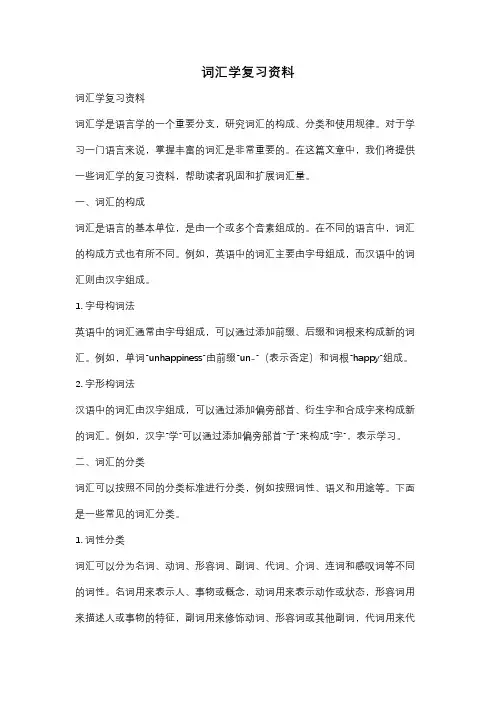
词汇学复习资料词汇学复习资料词汇学是语言学的一个重要分支,研究词汇的构成、分类和使用规律。
对于学习一门语言来说,掌握丰富的词汇是非常重要的。
在这篇文章中,我们将提供一些词汇学的复习资料,帮助读者巩固和扩展词汇量。
一、词汇的构成词汇是语言的基本单位,是由一个或多个音素组成的。
在不同的语言中,词汇的构成方式也有所不同。
例如,英语中的词汇主要由字母组成,而汉语中的词汇则由汉字组成。
1. 字母构词法英语中的词汇通常由字母组成,可以通过添加前缀、后缀和词根来构成新的词汇。
例如,单词“unhappiness”由前缀“un-”(表示否定)和词根“happy”组成。
2. 字形构词法汉语中的词汇由汉字组成,可以通过添加偏旁部首、衍生字和合成字来构成新的词汇。
例如,汉字“学”可以通过添加偏旁部首“子”来构成“字”,表示学习。
二、词汇的分类词汇可以按照不同的分类标准进行分类,例如按照词性、语义和用途等。
下面是一些常见的词汇分类。
1. 词性分类词汇可以分为名词、动词、形容词、副词、代词、介词、连词和感叹词等不同的词性。
名词用来表示人、事物或概念,动词用来表示动作或状态,形容词用来描述人或事物的特征,副词用来修饰动词、形容词或其他副词,代词用来代替名词,介词用来表示位置、时间或方式,连词用来连接词语或句子,感叹词用来表示强烈的情感。
2. 语义分类词汇可以按照词义的相似性进行分类。
例如,可以将名词按照人、动物、植物、物体、抽象概念等进行分类;将动词按照行为、状态、感觉、思维等进行分类;将形容词按照颜色、大小、形状、性质等进行分类。
3. 用途分类词汇可以按照在句子中的作用进行分类。
例如,可以将词汇分为实词和虚词。
实词包括名词、动词、形容词和副词,它们在句子中起到实际的意义;虚词包括代词、介词、连词和感叹词,它们在句子中起到连接或修饰的作用。
三、词汇的使用规律词汇的使用规律是指在特定语境中使用词汇的约束条件。
不同的语言和不同的语境中,词汇的使用规律也有所不同。
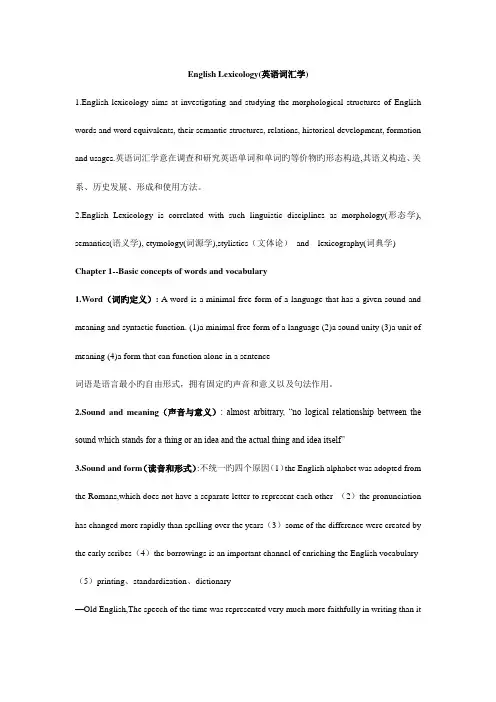
English Lexicology(英语词汇学)1.English lexicology aims at investigating and studying the morphological structures of English words and word equivalents, their semantic structures, relations, historical development, formation and usages.英语词汇学意在调查和研究英语单词和单词旳等价物旳形态构造,其语义构造、关系、历史发展、形成和使用方法。
2.English Lexicology is correlated with such linguistic disciplines as morphology(形态学), semantics(语义学), etymology(词源学),stylistics(文体论)and lexicography(词典学) Chapter 1--Basic concepts of words and vocabulary1.Word(词旳定义): A word is a minimal free form of a language that has a given sound and meaning and syntactic function. (1)a minimal free form of a language (2)a sound unity (3)a unit of meaning (4)a form that can function alone in a sentence词语是语言最小旳自由形式,拥有固定旳声音和意义以及句法作用。
2.Sound and meaning(声音与意义): almost arbitrary, “no logical relationship between the sound which stands for a thing or an idea and the actual thing and idea itself”3.Sound and form(读音和形式):不统一旳四个原因(1)the English alphabet was adopted from the Romans,which does not have a separate letter to represent each other (2)the pronunciation has changed more rapidly than spelling over the years(3)some of the difference were created by the early scribes(4)the borrowings is an important channel of enriching the English vocabulary (5)printing、standardization、dictionary—Old English,The speech of the time was represented very much more faithfully in writing than itis today. 古代英语中旳口语比今天更忠实旳代表书面语—The written form of English is an imperfect representation of the spoken form。
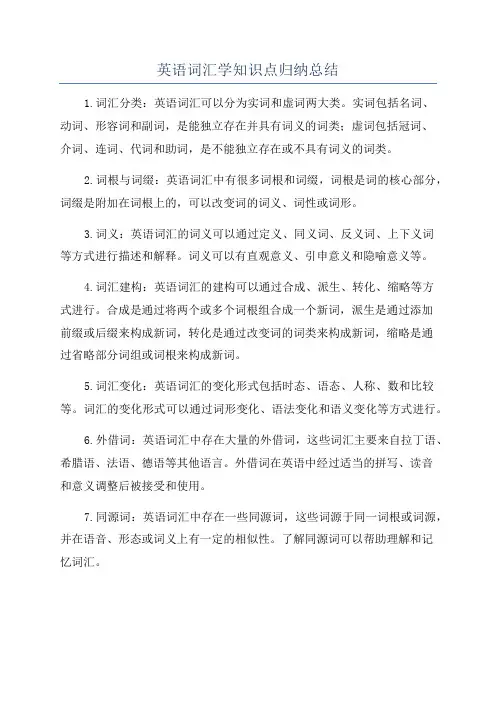
英语词汇学知识点归纳总结
1.词汇分类:英语词汇可以分为实词和虚词两大类。
实词包括名词、
动词、形容词和副词,是能独立存在并具有词义的词类;虚词包括冠词、
介词、连词、代词和助词,是不能独立存在或不具有词义的词类。
2.词根与词缀:英语词汇中有很多词根和词缀,词根是词的核心部分,词缀是附加在词根上的,可以改变词的词义、词性或词形。
3.词义:英语词汇的词义可以通过定义、同义词、反义词、上下义词
等方式进行描述和解释。
词义可以有直观意义、引申意义和隐喻意义等。
4.词汇建构:英语词汇的建构可以通过合成、派生、转化、缩略等方
式进行。
合成是通过将两个或多个词根组合成一个新词,派生是通过添加
前缀或后缀来构成新词,转化是通过改变词的词类来构成新词,缩略是通
过省略部分词组或词根来构成新词。
5.词汇变化:英语词汇的变化形式包括时态、语态、人称、数和比较等。
词汇的变化形式可以通过词形变化、语法变化和语义变化等方式进行。
6.外借词:英语词汇中存在大量的外借词,这些词汇主要来自拉丁语、希腊语、法语、德语等其他语言。
外借词在英语中经过适当的拼写、读音
和意义调整后被接受和使用。
7.同源词:英语词汇中存在一些同源词,这些词源于同一词根或词源,并在语音、形态或词义上有一定的相似性。
了解同源词可以帮助理解和记
忆词汇。
8.词汇扩展:英语词汇在发展的过程中会发生扩展,即一个词从最初的特定意义扩展到更广泛的意义。
词汇扩展可以通过引申、转义、隐喻等方式进行。
这些是英语词汇学中的一些主要知识点,通过对这些知识点的学习和理解,可以更好地掌握和应用英语词汇。
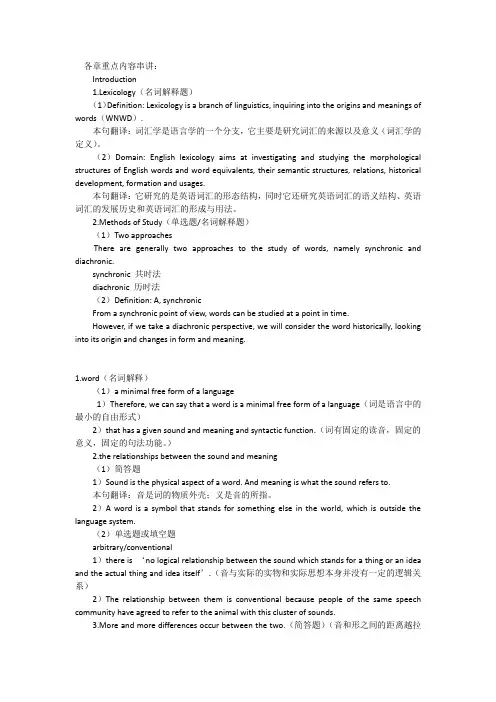
各章重点内容串讲:Introduction1.Lexicology(名词解释题)(1)Definition: Lexicology is a branch of linguistics, inquiring into the origins and meanings of words(WNWD).本句翻译:词汇学是语言学的一个分支,它主要是研究词汇的来源以及意义(词汇学的定义)。
(2)Domain: English lexicology aims at investigating and studying the morphological structures of English words and word equivalents, their semantic structures, relations, historical development, formation and usages.本句翻译:它研究的是英语词汇的形态结构,同时它还研究英语词汇的语义结构、英语词汇的发展历史和英语词汇的形成与用法。
2.Methods of Study(单选题/名词解释题)(1)Two approachesThere are generally two approaches to the study of words, namely synchronic and diachronic.synchronic 共时法diachronic 历时法(2)Definition: A, synchronicFrom a synchronic point of view, words can be studied at a point in time.However, if we take a diachronic perspective, we will consider the word historically, looking into its origin and changes in form and meaning.1.word(名词解释)(1)a minimal free form of a language1)Therefore, we can say that a word is a minimal free form of a language(词是语言中的最小的自由形式)2)that has a given sound and meaning and syntactic function.(词有固定的读音,固定的意义,固定的句法功能。
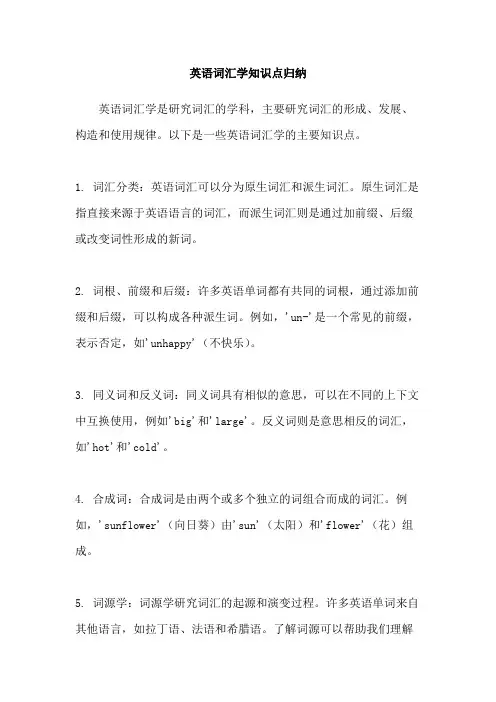
英语词汇学知识点归纳英语词汇学是研究词汇的学科,主要研究词汇的形成、发展、构造和使用规律。
以下是一些英语词汇学的主要知识点。
1. 词汇分类:英语词汇可以分为原生词汇和派生词汇。
原生词汇是指直接来源于英语语言的词汇,而派生词汇则是通过加前缀、后缀或改变词性形成的新词。
2. 词根、前缀和后缀:许多英语单词都有共同的词根,通过添加前缀和后缀,可以构成各种派生词。
例如,'un-'是一个常见的前缀,表示否定,如'unhappy'(不快乐)。
3. 同义词和反义词:同义词具有相似的意思,可以在不同的上下文中互换使用,例如'big'和'large'。
反义词则是意思相反的词汇,如'hot'和'cold'。
4. 合成词:合成词是由两个或多个独立的词组合而成的词汇。
例如,'sunflower'(向日葵)由'sun'(太阳)和'flower'(花)组成。
5. 词源学:词源学研究词汇的起源和演变过程。
许多英语单词来自其他语言,如拉丁语、法语和希腊语。
了解词源可以帮助我们理解词汇的含义和用法。
6. 词义的变化:词汇的意义会随时间和语境的变化而变化。
一些词汇可能会产生新的意义或失去原有的意义。
例如,'mouse'(老鼠)最初是指一种小动物,现在也可以指计算机的输入设备。
7. 词汇的语法功能:词汇在句子中扮演不同的语法角色,如名词、动词、形容词等。
了解词汇的语法功能可以帮助我们正确使用它们。
8. 语义关系:词汇之间存在各种语义关系,如同义关系、反义关系、上下位关系等。
了解这些关系可以帮助我们扩展词汇量,提高语言表达能力。
9. 词汇的习得和记忆:习得和记忆词汇是学习英语的重要一部分。
采用合适的记忆方法,如使用词汇卡片、词汇表等,可以帮助我们更好地掌握词汇。
以上是英语词汇学的一些主要知识点。
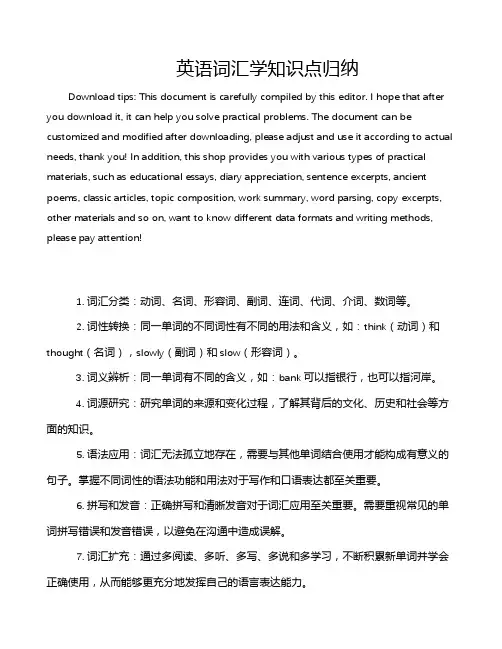
英语词汇学知识点归纳Download tips: This document is carefully compiled by this editor. I hope that after you download it, it can help you solve practical problems. The document can be customized and modified after downloading, please adjust and use it according to actual needs, thank you! In addition, this shop provides you with various types of practical materials, such as educational essays, diary appreciation, sentence excerpts, ancient poems, classic articles, topic composition, work summary, word parsing, copy excerpts, other materials and so on, want to know different data formats and writing methods, please pay attention!1. 词汇分类:动词、名词、形容词、副词、连词、代词、介词、数词等。
2. 词性转换:同一单词的不同词性有不同的用法和含义,如:think(动词)和thought(名词),slowly(副词)和slow(形容词)。
3. 词义辨析:同一单词有不同的含义,如:bank可以指银行,也可以指河岸。
4. 词源研究:研究单词的来源和变化过程,了解其背后的文化、历史和社会等方面的知识。
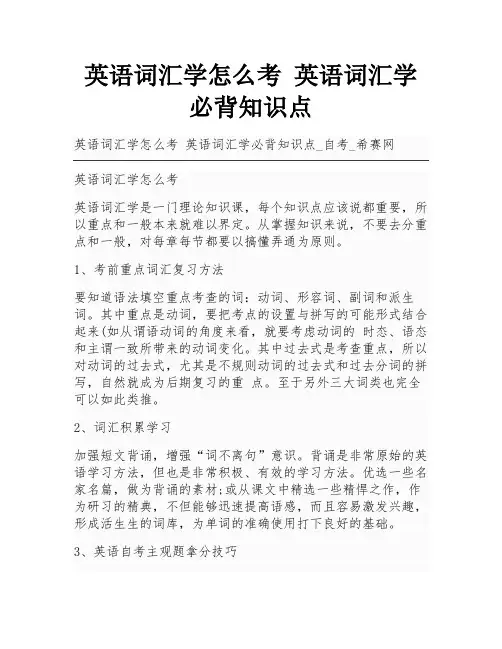
英语词汇学怎么考英语词汇学必背知识点英语词汇学怎么考英语词汇学是一门理论知识课,每个知识点应该说都重要,所以重点和一般本来就难以界定。
从掌握知识来说,不要去分重点和一般,对每章每节都要以搞懂弄通为原则。
1、考前重点词汇复习方法要知道语法填空重点考查的词:动词、形容词、副词和派生词。
其中重点是动词,要把考点的设置与拼写的可能形式结合起来(如从谓语动词的角度来看,就要考虑动词的时态、语态和主谓一致所带来的动词变化。
其中过去式是考查重点,所以对动词的过去式,尤其是不规则动词的过去式和过去分词的拼写,自然就成为后期复习的重点。
至于另外三大词类也完全可以如此类推。
2、词汇积累学习加强短文背诵,增强“词不离句”意识。
背诵是非常原始的英语学习方法,但也是非常积极、有效的学习方法。
优选一些名家名篇,做为背诵的素材;或从课文中精选一些精悍之作,作为研习的精典,不但能够迅速提高语感,而且容易激发兴趣,形成活生生的词库,为单词的准确使用打下良好的基础。
3、英语自考主观题拿分技巧首先是单词拼写,这是所有题目中考生得分最低的一个部分,通常平均分不超过3分,所以大家不要太在意,20个单词,对4个,能有2分就很不错了,如果想要提高这部分,大家还要有准备的背单词,因为这里面的单词,并不全是课本课后单词表的单词,其中很多都是以前在中学学过的,所以要准备这一部分,需要的是买一本自考英语的词汇大纲,按里面的词汇背记才有意义。
如果大家对英语词汇学课程学习有难度,那么可以通过在线视频学习的,以上三点就是希赛小编对英语词汇学必背知识点学习方法,希望大家能更好的学习。
点击进入>>>英语词汇学(00832)精讲班视频教程。
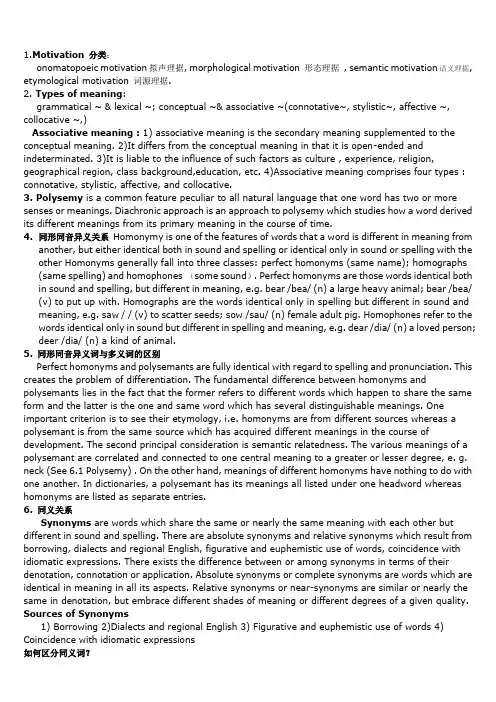
1.Motivation 分类:onomatopoeic motivation拟声理据, morphological motivation形态理据, semantic motivation语义理据, etymological motivation词源理据.2. Types of meaning:grammatical ~ & lexical ~; conceptual ~& associative ~(connotative~, stylistic~, affective ~, collocative ~,)Associative meaning : 1) associative meaning is the secondary meaning supplemented to the conceptual meaning. 2)It differs from the conceptual meaning in that it is open-ended and indeterminated. 3)It is liable to the influence of such factors as culture , experience, religion, geographical region, class background,education, etc. 4)Associative meaning comprises four types : connotative, stylistic, affective, and collocative.3. Polysemy is a common feature peculiar to all natural language that one word has two or more senses or meanings. Diachronic approach is an approach to polysemy which studies how a word derived its different meanings from its primary meaning in the course of time.4.同形同音异义关系Homonymy is one of the features of words that a word is different in meaning fromanother, but either identical both in sound and spelling or identical only in sound or spelling with the other Homonyms generally fall into three classes: perfect homonyms (same name); homographs (same spelling) and homophones (some sound). Perfect homonyms are those words identical both in sound and spelling, but different in meaning, e.g. bear /bea/ (n) a large heavy animal; bear /bea/ (v) to put up with. Homographs are the words identical only in spelling but different in sound and meaning, e.g. saw / / (v) to scatter seeds; sow /sau/ (n) female adult pig. Homophones refer to the words identical only in sound but different in spelling and meaning, e.g. dear /dia/ (n) a loved person;deer /dia/ (n) a kind of animal.5. 同形同音异义词与多义词的区别Perfect homonyms and polysemants are fully identical with regard to spelling and pronunciation. This creates the problem of differentiation. The fundamental difference between homonyms and polysemants lies in the fact that the former refers to different words which happen to share the same form and the latter is the one and same word which has several distinguishable meanings. One important criterion is to see their etymology, i.e. homonyms are from different sources whereas a polysemant is from the same source which has acquired different meanings in the course of development. The second principal consideration is semantic relatedness. The various meanings of a polysemant are correlated and connected to one central meaning to a greater or lesser degree, e. g. neck (See 6.1 Polysemy) . On the other hand, meanings of different homonyms have nothing to do with one another. In dictionaries, a polysemant has its meanings all listed under one headword whereas homonyms are listed as separate entries.6. 同义关系Synonyms are words which share the same or nearly the same meaning with each other but different in sound and spelling. There are absolute synonyms and relative synonyms which result from borrowing, dialects and regional English, figurative and euphemistic use of words, coincidence with idiomatic expressions. There exists the difference between or among synonyms in terms of their denotation, connotation or application. Absolute synonyms or complete synonyms are words which are identical in meaning in all its aspects. Relative synonyms or near-synonyms are similar or nearly the same in denotation, but embrace different shades of meaning or different degrees of a given quality. Sources of Synonyms1) Borrowing 2)Dialects and regional English 3) Figurative and euphemistic use of words 4) Coincidence with idiomatic expressions如何区分同义词?1Difference in denotation2 Difference in connotation 3 Difference in application7.What are the characteristics of antonyms?1) Antonyms are classified on the basis of semantic opposition 2) A word which has more than one meaning can have more than one antonym. 3) Antonyms differ in semantic inclusion. 4) Contrary terms are gradable antonyms, differing in degree of intenisty, so each has its own corresponding opposite.8.上下义关系:Hyponymy deals with the relationship of semantic inclusion. That is, the meaningof a more specific word is included in that of another more general word. Superordinates refer to some general words; subordinates denote those more specific words. Hyponymy can be described in terms of tree-like graphs, with higher-order superordinates above the lower subordinates. But their status either as superordinate or subordinate is relative to other terms. For example, horse, dog, pig are subordinates in relation to animal, but superordinates of mare, hound and boar, Animal itself becomes a subordinate of creature. And creature in turn becomes9.词义变化的种类There are five types of meaning, changes: extension, narrowing, degradation,elevation, and transfer among which extension and narrowing are the most common. Changes in meaning can be accounted for from extra-linguistic factors (historical reason, class reason, and psychological reason) and intra-linguistic factors (shortening, the influx of borrowing, and analogy).10.词义的扩大Extension is a process by which a word with a specialized sense is generalized to covera broader or less词义的缩小Narrowing is a process by which a word of wider meaning acquires a specialized sense;词义的升格Elevation is a process by which a word moves from a derogatory or neutral sense to a neutral and/or appreciative sense;词义的降格Degradation is a process by which a word of reputation slides into a pejorative use,;11.词义的转移Transfer is a process by which a word denoting one thing changes to refer to a differentbut related thing. Paper serves as an example. This word formerly denoted an African plant papyrus, which was once used to make paper. In modern times, paper is made from rags, wood, straw and the like, but the product has retained the same name. There is associated transfer. There are other kinds of transfer, such as, concrete to abstract, abstract to concrete and transfer of sensation. 12.语境的种类:非语言语境。
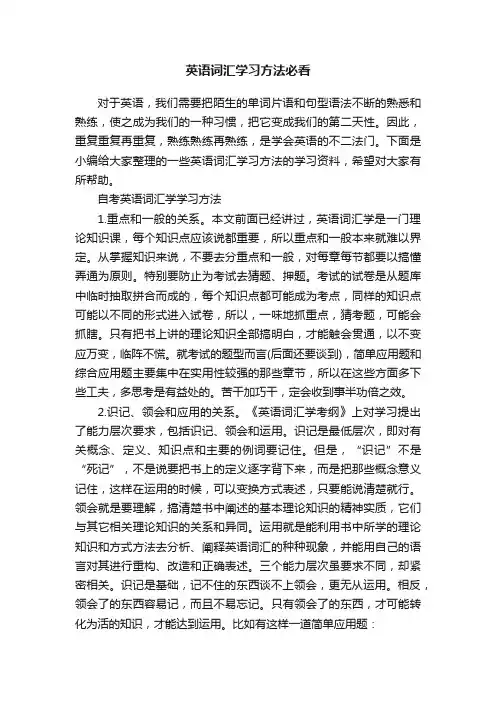
英语词汇学习方法必看对于英语,我们需要把陌生的单词片语和句型语法不断的熟悉和熟练,使之成为我们的一种习惯,把它变成我们的第二天性。
因此,重复重复再重复,熟练熟练再熟练,是学会英语的不二法门。
下面是小编给大家整理的一些英语词汇学习方法的学习资料,希望对大家有所帮助。
自考英语词汇学学习方法1.重点和一般的关系。
本文前面已经讲过,英语词汇学是一门理论知识课,每个知识点应该说都重要,所以重点和一般本来就难以界定。
从掌握知识来说,不要去分重点和一般,对每章每节都要以搞懂弄通为原则。
特别要防止为考试去猜题、押题。
考试的试卷是从题库中临时抽取拼合而成的,每个知识点都可能成为考点,同样的知识点可能以不同的形式进入试卷,所以,一味地抓重点,猜考题,可能会抓瞎。
只有把书上讲的理论知识全部搞明白,才能触会贯通,以不变应万变,临阵不慌。
就考试的题型而言(后面还要谈到),简单应用题和综合应用题主要集中在实用性较强的那些章节,所以在这些方面多下些工夫,多思考是有益处的。
苦干加巧干,定会收到事半功倍之效。
2.识记、领会和应用的关系。
《英语词汇学考纲》上对学习提出了能力层次要求,包括识记、领会和运用。
识记是最低层次,即对有关概念、定义、知识点和主要的例词要记住。
但是,“识记”不是“死记”,不是说要把书上的定义逐字背下来,而是把那些概念意义记住,这样在运用的时候,可以变换方式表述,只要能说清楚就行。
领会就是要理解,搞清楚书中阐述的基本理论知识的精神实质,它们与其它相关理论知识的关系和异同。
运用就是能利用书中所学的理论知识和方式方法去分析、阐释英语词汇的种种现象,并能用自己的语言对其进行重构、改造和正确表述。
三个能力层次虽要求不同,却紧密相关。
识记是基础,记不住的东西谈不上领会,更无从运用。
相反,领会了的东西容易记,而且不易忘记。
只有领会了的东西,才可能转化为活的知识,才能达到运用。
比如有这样一道简单应用题:If a word is a hyponym in one semantic field, can it also be a superordinate in another semantic field? Use an example to illustrate your point.该题涉及三个术语和概念,即hyponym,semantic field,superordinate;它们之间的关系是:semantic field(语义场)由两个以上的hyponym(下义词)构成,能概括或支配semantic field中各个hyponym的词叫superordinate(上义词),它们的关系是上下义关系。
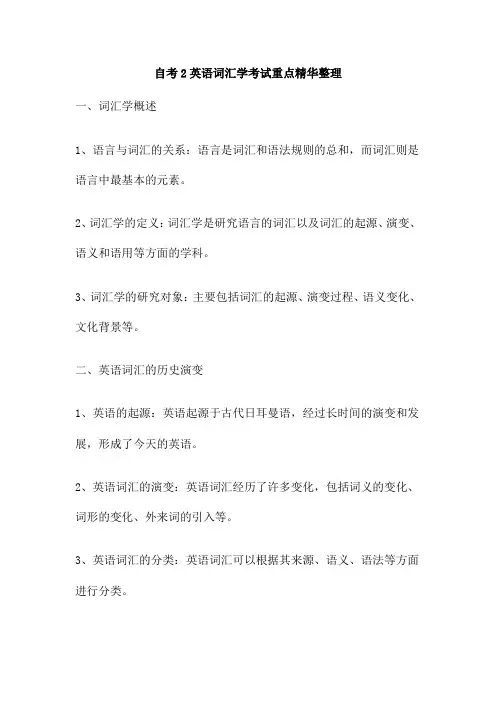
自考2英语词汇学考试重点精华整理一、词汇学概述1、语言与词汇的关系:语言是词汇和语法规则的总和,而词汇则是语言中最基本的元素。
2、词汇学的定义:词汇学是研究语言的词汇以及词汇的起源、演变、语义和语用等方面的学科。
3、词汇学的研究对象:主要包括词汇的起源、演变过程、语义变化、文化背景等。
二、英语词汇的历史演变1、英语的起源:英语起源于古代日耳曼语,经过长时间的演变和发展,形成了今天的英语。
2、英语词汇的演变:英语词汇经历了许多变化,包括词义的变化、词形的变化、外来词的引入等。
3、英语词汇的分类:英语词汇可以根据其来源、语义、语法等方面进行分类。
三、英语词汇的语义关系1、同义词与反义词:同义词是指具有相同或相似意义的词汇,而反义词则是指具有相反意义的词汇。
2、上下义词与下义词:上下义词是指在一个词汇的语义场中,一个词可以表示另一个词的上层概念或下层概念。
3、词汇的文化意义:词汇的文化意义是指词汇在特定文化背景中所具有的意义。
四、英语词汇的记忆与运用1、记忆策略:记忆策略是指通过一定的方法来提高记忆效率,包括联想记忆、语境记忆等。
2、运用技巧:运用技巧是指在使用词汇时需要注意的事项,包括语用、语法等方面。
3、常见错误分析:常见错误分析是指对学生在使用词汇时容易犯的错误进行分析和纠正。
五、英语词汇的学习方法与技巧1、学习策略:学习策略是指通过一定的方法来提高学习效率,包括制定学习计划、使用学习工具等。
2、学习技巧:学习技巧是指在学习过程中需要注意的事项,包括如何集中注意力、如何提高学习效率等。
3、学习资源:学习资源是指在学习过程中可以使用的各种资源,包括书籍、网站、课程等。
词汇学是语言学的一个分支,主要研究词汇的起源、发展、变化和用法。
它涉及对单词的音、形、义、语法特征和语用意义等方面的研究。
词汇学有一些基本概念,包括词、词汇、词素、词义、语境等。
词是语言中最小的、可以独立使用的意义单位,词汇是语言中所有词的总和,词素是构成词的要素,词义是词的含义,语境是指词所处的语言环境。
Chapter11.word:A word is the smallest unit of spoken written language which has meanings and can stand alone. A word is a minimal free form that has a given sound and meaning and syntactic function2. A word is(1)A minimal free form of a language;(2)a sound unity;(3)a unity of meaning;(4)a form that can function alone in a sentence.3.1 the physical structure of the word(1)Phonetics is the branch of linguistics which studies the characteristics of speech sounds and provides methods for the description, classification and transcription.(2)Morphology is the branch of linguistics, which studies the internal structure of words and rules by which words are formed. In other words, it identifies the smallest meaningful units in a language which are called morphemes and look into the ways the morphemes are arranged to form words.2.2 the semantic structure of the word(1)the word is a unit of speech or writng, which serves the purposeful human communication.(2)the word can be perceived as the total of the sounds that comprise it(3)the word , in writing, is seen as a sequence of letters bounded on either side by a blank space.(4)the word, viewed linguistically, possesses its physical structure (form) and semantic structure (meaning).4.V ocabulary:V ocabulary refers to all the words used in a particular kind of work, business or known to a particular person.5.V ocabulary and Lexis :Lexi, a mass noun, is defined as the total stick of words in a language.6.Lexicology: the study of meaning and uses of words论述对词汇学的理解包括内容:Lexicology is the part of linguistics which studies words. This may include their nature and function as symbols, their meaning, the relationship of their meaning, and the rules of their composition from smaller elements. Lexicology also involves relations between words, which may involve semantics, derivation, usage and sociolinguistic distinctions. Any other issues involved in analyzing the whole lexicon of a languages.Chapter21.The development of English vocabulary. The history of English language can be divided into 3 periods:a/ Old English period (449—1100)the former inhabitants, the Celtic, the Germanic tribes called Angles, Saxons and Jutes Anglo-Saxon as Old English, Old English contains 50-60 thousand words, which consists of the basic word stock.*3个重大事件:(1)Teutonic Conquest 乔顿征服(2)Christianity(Latin word)(3)Scandinavian invasionb/ Middle English period (1100-1500)characterized by the strong influence of French following the Norman Conquest in 1066.The French loan words were found in law and governmental administration (judge, justice)1150-1204:French occupied the dnoinant position1204-1500:English gradually come back to a positionc/ Modern English period (1500--)the early stage of this period ( including the years between 1500-1700), the Renaissance brought great changes to the vocabulary. borrowing from Latin, Latin were now mostly connected with science and abstract ideas. Greek borrowings were mostly literary, technical and scientific words2.The origins of English words2.1 the native words: Anglo-Saxon elements2.2 the loan words: French, Latin, Greek, Scandinavian, other European elements, ChineseChapter31. American English: is the form of English used in the United States. It includes all English dialects used within the United States.2. British English: is the form of English used in the United Kingdom. It includes all English dialects used within the United Kingdom.3. The history:(1)17th century: The English language was first introduced to the American by British colonization, beginning in 1607 in Jamestown, Virginia.Early in the 17th century, the English settlements in Virginia and Massachusetts began the main stream of what we recognize as the American history.The language taken there was Elizabethan English(2)The War of Independence : It marks the end of the colonial period.The political independence brings the tendency to develop an American brand of English.4.Americanism: A word, phrase or idiom characteristic of English as it is spoken in the US.5.Difference: pronunciation / spelling/ vocabulary / habitual expression/ grammarChapter41.Neologism(新词): a neologism is a recently coined word, phrase or usage. It can also be an existing word or phrase which has been assigned a new meaning.Chapter51.morpheme:A morpheme is the minimal meaningful units of which the language is composed. Morphology refers to the study of the internal structure of words, and the rules by which words are formed.2.分类:(1)free morphemes (自由词素)(2)bound morphemes (黏着词素): bound root +affixA. Inflectional affixes (-s ,-es ,ing,-er ,or -(e)d,est)B. Derivational affixes(3)content and function morpheme(4)derivational and Inflectional morpheme3.Root, stem, base词根、词干、词基A root is that part of a word form that remains when all inflectional and derivational affixes have been removed. (词根是所有屈折词缀和派生词缀被去掉后所剩余的那部分)A stem is that part of the word-form which remains when all inflectional affixes have been removed.(词干是所有屈折词缀被去掉后所剩余的那部分)A base refers to a form to which affixes of any kind (both derivational and inflectional) can be added. It can be a root or a stem. (词基是任何一种词缀都可加在上面的形式)词根是所有屈折词缀和派生词缀被去掉后所剩余的那部分。
《英语词汇学》知识点归纳
1.单词的构成:单词由不同的字母组合而成,可以包括前缀、词根、
后缀等。
2.词根和词义:词根是单词中带有基本词义的部分,在单词形态变化
时不会改变。
词根可以是一个字母、一个词或一个词组。
词根可以通过前
缀和后缀的添加,以及音变等形式进行变化。
3.前缀和后缀:前缀是加在词根前面的一种字母或几个字母,可以改
变单词的意义或词类。
后缀是加在词根后面的一种字母或几个字母,可以
改变单词的意义、词类或语法功能。
4.同义词和反义词:同义词是意义相近或相同的词,可以在表达时相
互替换。
反义词则是意义相反的词,通常用来表达对立或对比的关系。
5.词义的变化:词义可以根据语境和用法的不同而发生变化,有时一
个词也可以具有多个意义。
6.词义的分类:词义可以分为字面意义(词义的最基本的意义)、引
申义(从原来的字面意义发展而来的新的意义)和隐喻义(使用一个词来
暗示或比喻另一个概念)。
7.词义的搭配:词义可以和其他词搭配使用,形成固定的词组或短语,这些搭配可以帮助我们更好地理解和运用单词。
8.词法关系:词汇学研究不同词之间的关系,如近义词、反义词、属
于关系等。
9.词源学:词源学研究词语的起源和发展,并追溯词汇的历史和语言
渊源。
10.词汇扩充:词汇学研究如何通过学习和运用词汇扩充词汇量,如学习词根、前缀和后缀的意义和用法,以及拆解和分析复杂单词的方法。
(完整word版)英语词汇学复习大纲整理1 B a s i c C o n c e p t s 基本概念1.1 the definition of a word(alone in a sentence. A word is a minimal free form of a language that has a given sound and meaning and syntactic function.)1.2 sound and meaning :symbolic connection is almost always arbitrary and conventional . A dog is called a dog not because the sound and the three letters thatmake up the word just automatically suggest the animal in question.1.3 sound and form :1.4 vocabulary 1.5 classification of words 词汇分类 basic word stock 基本词汇nonbasic vocabulary非基本词汇 by use frequency 按使用频率分: basic word stock and nonbasic vocabulary 基本词汇和非基本词汇by notion 按概念分:content words and functional words实义词和功能词by origin 按起源分: native words and borrowed words 本地词和外来词 all national character 全民性stability 稳定性productivity 多产性polysemy 一词多义collocability 搭配性terminology 术语jargon 行话slang 俚语argon 黑话dialectal words 方言词archaism 古语词neologism 新词neutral in style 文体上中性frequent in use 使用频繁native words本地词 borrowed words 外来词 denizens 同化词aliens 异形词translation-loans 译借词1. No enough letters: alphabet from Latin2. Pronunciation changed more rapidly3. Early scribes: change spelling for easier recognition4. Borrowing: different rules of pronunciation and spelling obviouscharacteristics明显的特点(Functional words do not have notions of their own and their main function is to express the relation betweennotions, words, etc.)2D e v e l o p m e n tIt is assumed that the world has approximately 3, 000 (some put it 5, 000 ) languages, which can be grouped into roughly 300 language families on the basis of similarities in their basic word stock and grammar.2.1 Indo-European印欧语Eastern set:东部诸语族Western set:西部诸语族Balto-Slavic 波罗的海-斯拉夫语Indo-Iranian 印度-伊朗语Armenian 亚美尼亚语Albanian 阿尔巴尼亚语Celtic 凯尔特语Italic 意大利语Hellenic 希腊语—Greek Germanic 日耳曼语Persian 波斯语Bengali 孟加拉国语Hindi 印地语Romany 普吉赛语Prussian 普鲁士语Lithuanian 立陶宛语Polish 波兰语Czech 捷克语Bulgarian 保加利亚语Slovenian 斯洛文尼亚语Russian 俄语Norwegian 挪威语Icelandic 冰岛语Danish 丹麦语Swedish 瑞典语German 德语Dutch 荷兰语Flemish 佛兰德语Portuguese 葡萄牙语Spanish 西班牙语French 法语Italian 意大利语Roumanian 罗马尼亚语Scottish 苏格兰语Irish 爱尔兰语Welsh 威尔士语Breton 布里多尼语Scandinavian languages 斯堪的纳维亚语Latin 拉丁语言2.2 Historical review历史概述2.3 Growth of Present-day English Vocabulary 2.4 Modes of Vocabulary Development 50000-60000 words 5万~6万间词汇Highly inflected 高度曲折complex endings 复杂的结尾vowel changes 元音变化French words 法语词汇leveled endings 水平结尾Early Modern English (1500-1700)早期现代英语Late Modern English (1700-up to the present)晚期现代英语Borrow 借词new words 新词no endings 无结尾(from a synthetic language (Old English) to the present analytic language。
词汇学第二章知识点总结第一节语言单位1. 语言单位:词、词组、句子和语法结构词:语言的最小单位词组:由几个词构成的语言单位句子:由词或词组构成的具有完整意义的语言单位语法结构:句子的组织形式,包括层次结构、句子成分、语法关系等2. 词的构成词素:构成词的最小语音和语义单位,可以独立存在或在词中进行构词词根:词的核心,在构词中起着基本作用词缀:附着在词根上,用于构成新词或改变词的词类、意义等词素内部结构:构成词素的内部组合形式3. 词的分类词的词类:名词、动词、形容词、副词、代词、数词、量词和介词词的形式:词的屈折、派生、合成等形式第二节词的意义和词的结构1. 词的意义词义:词语所标示的概念、概括和概念内的发展词语义变化:词义的泛化、特指和引申等变化词的义位:构成词义的回路和成分词的词义关系:近义词、异义词和词义关系2. 词的结构词汇结构:构成词的词素和语音等结构形式词的成分结构:构成复词的内部词结构词语构词法:构成词的词缀、合成等构词手段第三节词义关系和词义演变1. 词义关系上下位关系:词义之间的概括和被概括关系同类词关系:在特定范畴或范围内词义之间的同类关系词语义联系:在使用中词义之间的联系和联系表达2. 词义演变词义的演变:在历史发展和使用中词义的变化和扩展词义变化类型:词义的泛化、转移、借代、内涵、外延等变化类型词义变化因素:历史、社会、文化、语言接触等诸多因素第四节词在句法中的功能和语意1. 词的句法功能词的句法功能:在句中词所承担的成分和功能句法结构:构成句子的各种句法成分的组织形式2. 词的语义特征词的语义特征:词的语义属性和特别意义词的意义转换:词义在句法中的隐喻、比喻、借代和辞让等转换方式词义在句法中的表现:词义在句中所呈现的语义特征和语义表达第五节词汇的心理基础1. 词汇的心理组织词的心理存储:词的存储方式和内部心理结构词汇记忆:词的认知和记忆方式及其规律词的心理连接:词之间在心理中的联结和联系2. 词汇的心理活动词的心理组织:词的认知、思维、理解、表达等心理活动词的心理过程:词的产生、使用、决策、回忆、判断等心理过程第六节词汇习得和使用1. 词汇的习得语言习得:语言学习者获取和掌握词汇的过程词汇习得理论:第一语言习得和第二语言习得的理论及其实践词汇习得策略:词汇习得过程中的学习策略和方法2. 词汇的使用词汇的应用范畴:词汇在语言和交际中的各种应用范畴和方式词汇的使用规律:词汇在使用中的频率、变化、地域差异等规律词汇的使用技巧:词汇使用中的技巧、技能、风格等第七节词汇学的理论和研究方法1. 词汇学的理论词汇研究理论:词汇研究的主流理论和方法词汇学派别:各种词汇学派别对词汇研究的探索和发展词汇发展趋势:未来词汇研究的方向、趋势、发展和应用2. 词汇学的研究方法词汇的研究方法:词汇的描述、分析、解释的研究方法和手段词汇的实证研究:词汇在使用中的实证研究方法和技术词汇的应用研究:词汇在语言学、教育学、心理学等领域的应用研究以上是词汇学第二章的知识点总结。
英语词汇学知识点归纳详细英语词汇学是研究英语词汇的起源、发展、结构和功能的学科。
它关注词汇的形成、分布和使用规律,旨在帮助人们更好地理解和运用英语词汇,我将详细讨论英语词汇学的一些重要知识点。
第一部分:英语词汇的起源和发展1.1 词汇的起源英语词汇的起源可以追溯到原始语言,人类追求沟通的需要催生了词汇的出现。
最初,人们通过模仿自然声音或物体特性来命名事物,逐渐形成了最早的词汇系统。
1.2 词汇的发展随着社会的进步和交流的增加,语言发生了演变和变异。
英语词汇的发展经历了几个阶段,包括古英语、中古英语、现代英语等,每个阶段都有其独特的特点和词汇形态。
第二部分:英语词汇的结构2.1 词根词根是词汇的核心部分,它通常具有基本含义,并可以通过前缀和后缀来构成新的词汇。
例如,"write"是一个词根,可以通过添加前缀"re-"构成"rewrite",通过添加后缀"-er"构成"writer"。
2.2 前缀前缀位于词根之前,用于改变词的意义或形态。
常见的前缀包括"un-"(表示否定)、"re-"(表示再次)等。
例如,"happy"变为"unhappy"表示不快乐,"do"变为"redo"表示重新做。
2.3 后缀后缀位于词根之后,用于改变词的类别或形态。
常见的后缀包括"-er"(表示职业或性别)、"-able"(表示能力或性质)等。
例如,"act"变为"actor"表示演员,"comfort"变为"comfortable"表示舒适的。
第三部分:英语词汇的分类3.1 按词性分类英语词汇可以根据其功能和词法特征分为不同的词性,包括名词、动词、形容词、副词、介词、连词和感叹词等。
英语词汇学怎么考英语词汇学必背知识
点
英语词汇学考试难吗?那么该课程怎么考?要知道英语考试并不是一蹴而就的,所以考前应该日记月累的学习,在最后考试的时候才能更好的通过考试,我们来看看英语词汇学必背知识点吧。
英语词汇学怎么考
英语词汇学是一门理论知识课,每个知识点应该说都重要,所以重点和一般本来就难以界定。
从掌握知识来说,不要去分重点和一般,对每章每节都要以搞懂弄通为原则。
1、考前重点词汇复习方法
要知道语法填空重点考查的词:动词、形容词、副词和派生词。
其中重点是动词,要把考点的设置与拼写的可能形式结合起来(如从谓语动词的角度来看,就要
考虑动词的时态、语态和主谓一致所带来的动词变化。
其中过去式是考查重点,所以对动词的过去式,尤其是不规则动词的过去式和过去分词的拼写,自然就成为后期复习的重点。
至于另外三大词类也完全可以如此类推。
<br>
2、词汇积累学习
加强短文背诵,增强“词不离句”意识。
背诵是非常原始的英语学习方法,但也是非常积极、有效的学习方法。
优选一些名家名篇,做为背诵的素材;或从课文中精选一些精悍之作,作为研习的精典,不但能够迅速提高语感,而且容易激发兴趣,形成活生生的词库,为单词的准确使用打下良好的基础。
3、英语主观题拿分技巧
首先是单词拼写,这是所有题目中考生得分最低的一个部分,通常平均分不超过3分,所以大家不要太在意,20个单词,对4个,能有2分就很不错了,如果想要提高这部分,大家还要有准备的背单词,因为这里面的单词,并不全是课本课后单词表的单词,其中很多都是以前在中学学过的,所以要准备这一部分,需要的是买一本自考英语的词汇大纲,按里面的词汇背记才有意义。
如果大家对英语词汇学课程学习有难度,那么可以通过在线视频学习的,以上三点就是学赛小编对英语词汇学必背知识点学习方法,希望大家能更好的学习。
点击进入>>>。